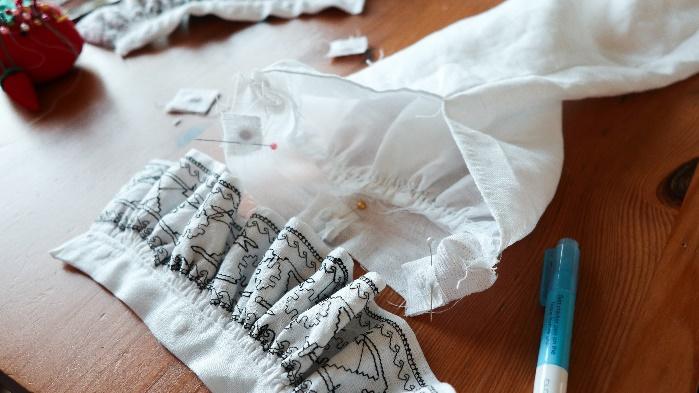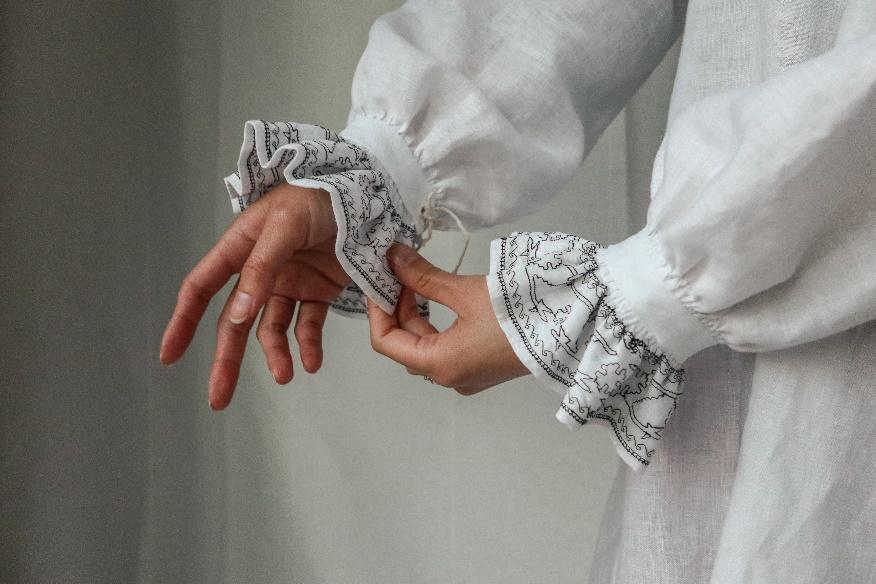
Do you have an interest in historical costuming? With more events opening up it is time to get stitching up costumes, cosplay, or garments! Janome Maker Adrienne Chiu from Wax Sealed Costumes utilized the embroidery feature on her Skyline S9 to create these lovely magnetic removable 16th-century blackwork embroidery frills.

Planning ahead for when renaissance faires can safely happen again, I’ve started to work on my first more historically accurate/inspired mid-16th century outfit. I pre-ordered the new Typical Tudor book from The Tudor Tailor, but publication is delayed until this spring. Last winter, I was able to pattern test for them, and since I’m starting from the skin out, I chose the shift pattern. I made it from some shift weight linen and linen thread from Burnley and Trowbridge and sewed it with my Janome Skyline S9.
Fancy wrist cuffs and neck ruffs in the 16th century were made to be detachable so that the smock or shift could be easily laundered separately. These would be sewn/basted on, which is what I’ve done with my 18th-century engagements in the past. The guild I attend renaissance faire with does historical European martial arts demonstrations and wrist frills don’t fit in my gauntlets without getting crushed. Unpicking and resewing cuffs multiple times a day isn’t practical, so I chose to make magnetic removable cuffs to easily take them on and off during the day.
Here’s how to make your very own magnetic removable blackwork embroidery cuffs!
I started off with designing my blackwork embroidery for the cuffs. While searching for inspiration, I noticed that an element in Jane Seymour’s frills in this painting looked like shields. I took that as a base and changed up the design to add in a sword and halberd, so my cuffs would be on theme for my ren faire guild.
Jane Seymour was painted by Hans Holbein In 1536. Zoom in to all the gorgeous details here: https://artsandculture.google.com/asset/egE1bExAbnBDgg
This was my first time digitizing machine embroidery. I started off in Adobe Photoshop and quickly realized I needed to switch to Adobe Illustrator so that I could import the vector file into Stitch Era, the program I used to convert the vectors into machine embroidery files.
I did test stitch runs – after the first one, I realized one element was too small and making the whole design inefficient, so I took it out entirely. Hand-done blackwork embroidery, particularly with the Holbein stitch, creates a reversible piece, but with machine embroidery, the backside doesn’t perfectly match the front (especially if you use thinner bobbin thread as I do), so I mirrored the design and folded the piece in half to create two “good” sides of the frill.
Now it was time for the real deal. This is my first time stitching a repeating/continuous machine embroidery pattern, so I’m still learning the best ways to line pieces up. I added a piece of draping tape to the hoop grid as an extra reference marker. The Skyline S9 also has features to move the hoop/needle to each corner of the piece, which I used to check alignment. I also jumped ahead in the stitch count to check alignment in a few key spots in the middle of my piece.
I stitched my design out on the RE20a hoop and did three repeats to get the length I wanted, which is slightly longer than the frill piece in my Tudor Tailor pattern. This is the biggest hoop for the Janome Skyline S9 with 170x200mm of usable space. The backside is stabilized with Sulky Solvy Water Soluble Stabilizer – I have a tearaway stabilizer, but my design has so many small stitches, it would be very tedious to tear all those out, so I went with a washable one.

My two lengths of embroidery were washed and dried to remove the water-soluble stabilizer. I cut these out with a ½” seam allowance.

On each short end, fold them right sides together, stitch, clip the corner, turn, and press to create the double-sided embroidery piece.

To make the sewable magnets, I chose small magnets because I wanted to make sure they fit inside the cuff, were soft and relatively unobtrusive. Ready-made sewable magnets I could find were all wider in diameter, thicker, and covered with plastic. Comfort is key as I’d be some of wearing these inside gauntlets while sparring.

I cut small lengths of linen from leftovers, folded them over to encase the magnets, and used pins to hold the magnets in place while getting it aligned to sew on the machine (the magnet will want to stick to the needle plate). Start at one corner, sew a straight line to the edge of the magnet, keep the needle down, lift the presser foot, rotate the whole piece 45 degrees, bring down the presser foot and keep sewing. Repeat until all four sides are sewn and the magnet is fully encased. I went with 3 magnets along my cuff and you’ll need a set for the shift cuff and the removable frill cuff, so a total of 12 magnets.
Use the gathering stitch setting and sew at least two rows of stitches along the raw edge side and pull on the bobbin threads to gather the frill to the cuff length.

Cut out cuff bands that match the cuffs you use on your shift sleeve end. Sewing your new sewable magnets to one side and then fold in half lengthwise and press. If you plan on sewing buttonholes or eyelets to your sleeve cuffs, keep that in mind and leave some space for those/don’t block it with your magnets. (I went with eyelets for mine)
Pin your gathered frill to your cuff, right sides, and raw edges together, and sew. (Note: if you happen to have a preferred side of your frill to show on the outside, then sew the cuff band such that the magnets will also be on that side). Then fold and sew the short ends (like you did with the frills), clip, and turn them right side out. You should be ready to turn in the raw edge of the cuff band and encase the raw edges of your frill now. Since this won’t be visible, I chose to machine sew the cuff band down with the dual feed foot.
Use the same method to sew the magnets to the cuff of your shift. I used a Clover water soluble marker to make sure the magnets are aligned and be sure to triple check you have the magnets facing the right way so the two cuff bands will stick together! Remember the note from above? For the strongest connection, I sewed the magnets to the wrist-facing layer of the sleeve cuff and the outer-facing layer of the removable cuff. The finished removable cuff will attach along the inside of your sleeve cuff.

Since the sleeve-side cuff will be visible, I chose to hand whip stitch the inside of the band to the sleeve.
If your embroidery design has some jump threads, remember to clean those up. I was so eager to keep working on my cuff, I didn’t trim these until the end, and the gathered frill made it a little harder, so I recommend doing this right after you finish embroidering.
And there you have it. Magnetic removable blackwork embroidery cuffs – perfect for when you don’t feel like being so fancy or they’re getting in the way of putting on gauntlets. You can use this magnet method to make other accessible clothing accessories as well!

